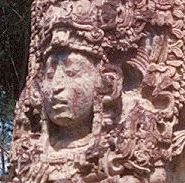Waxaklajuun Ub'aah K'awiil
Waxaklajuun Ub'aah K'awiil , also known as 18 Rabbit , (* around 675 in Copan , † May 3 738 in Quiriguá ) of the 13th and at the same time most significant was ruler of the Maya - the city-state Copan.
His enthronement took place on July 9, 695.
During his reign, construction activity in Copán increased by leaps and bounds, and the sculptural, unique style of stonework that is typical of Copán flourished.
Between 711 and 736, 18 rabbits had a total of eight steles erected to show him on different occasions. The stele J, which he erected as his first monument at the eastern entrance to the city as early as 702, is unusual in that the hieroglyphs are arranged like a woven pattern and must be read in the correct order for correct understanding. Stele A is also of particular importance, as Copán 731 is named as one of the four main centers of Mayan culture, along with Palenque , Tikal and Calakmul .
The construction or renovation of several buildings also fall under his rule. The Mayan Acropolis was renewed and Temple 22 was built, and finally the ball playground was restored.
On April 29, 738 he was captured by K'ak 'Tiliw Chan Yopaat , whom he himself had installed as a vassal in Quiriguá 725, after several years of war, which can also be seen in connection with the all-determining conflict between Tikal and Calakmul and beheaded in Quiriguá . With this event, which was celebrated in numerous inscriptions in Quiriguá, its ascent is justified, while Copán fell into an agony of almost 20 years .
literature
- Simon Martin, Nikolai Grube : Chronicle of the Maya Kings and Queens: Deciphering the Dynasties of the Ancient Maya. London and New York 2008, pp. 203-205.
Individual evidence
- ↑ Nikolai Grube (ed.): Maya, Gottkönige im Regenwald. Potsdam 2012, ISBN 978-3-8480-0033-3 , p. 121.
- ↑ Nikolai Grube (ed.): Maya, Gottkönige im Regenwald. Potsdam 2012, ISBN 978-3-8480-0033-3 , p. 292.
- ^ Matthew G. Looper: New Perspectives on the Late Classic Political History of Quirigua, Guatemala. In: Ancient Mesoamerica 10/2, 1999, pp. 263-280.
| personal data | |
|---|---|
| SURNAME | Waxaklajuun Ub'aah K'awiil |
| ALTERNATIVE NAMES | 18 rabbits |
| BRIEF DESCRIPTION | Ruler of the Maya city-state es Copán (395–738) |
| DATE OF BIRTH | at 675 |
| PLACE OF BIRTH | Copan |
| DATE OF DEATH | May 3, 738 |
| Place of death | Quiriguá |




